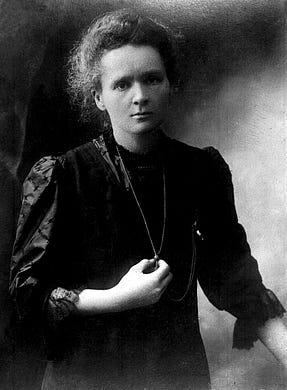|
 |
The Writer's Almanac from Tuesday, November 7, 2017
“Why I Love Being Married to a Chemist” by Barbara Crooker from Les Fauves. © C & R Press, 2017.
ORIGINAL TEXT AND AUDIO - 2017
It’s the birthday of Polish physicist and chemist Marie Curie (1867). Curie discovered radium, without which we wouldn’t have X-rays or certain cancer therapies. Curie was born in Warsaw, which is now Poland, but used to be part of the Russian Empire. She went on to win two Nobel Prizes, but she always donated her prize money and remained humble about her achievements. She once summed up her potential biography as, “I was born in Poland. I married Pierre Curie, and I have two daughters. I have done my work in France.”
Curie came from a family of teachers who believed so strongly in education that her father brought home discarded test tubes from the laboratory at his school and encouraged Marie to perform experiments. Because she was a girl, she couldn’t go to University. So she began studying clandestinely at what was called a “Floating University,” a secret set of informal, underground classes held in Warsaw.
She met her husband, Pierre, after moving to France to further her studies. They set up a lab in a decrepit warehouse outside their atelier. The warehouse had an asphalt floor, a glass roof broken in several places, and was heated by a cast-iron stove in the winter. They worked on worn-out tables, often eating simple meals of bread washed down with water.
Curie often stirred the heavy and hot molten mass of radioactive products in a caldron herself, sometimes slipping samples in her pockets and forgetting about them. No one knew then about the harmful effects of radiation. When she died in 1934, it was attributed to four decades of exposure to radioactivity.
Curie and Pierre discovered radium and polonium in 1898. A watchcase containing a speck of the radium was exhibited at the Paris Exposition in 1900. The label read, “Radium, discovered by Mme. Curie.”
During World War I, Curie and her daughter suggested that the armies equip automobiles with radiographic apparatus to treat the wounded, inadvertently inventing the X-ray and the ambulance at the same time. The X-ray could locate bullets and fragments in wounded soldiers, which meant quick, life-saving removal.
All of Marie Curie’s research materials and notes are too dangerous to examine because of their high level of radioactivity. They are kept in lead-lined boxes.
Today is the birthday of Danish author and poet Benny Andersen, born Vangede, a suburb of Copenhagen (1929). He’s the most popular poet in Denmark — indeed, a national literary hero — but most people in the United States have never heard of him. He worked as a pianist in a bar after he finished school, and published his first book of poetry in 1960. Since then, he has published 21 poetry volumes, as well as screenplays, children’s books, story collections, a novel, and a play. He’s also a musician and a songwriter. He has often collaborated with singer and musician Povl Dissing, and the two released an album, Svantes Viser (1973), with Dissing singing Andersen’s poems. The album has been included in the Danish Culture Canon, a collection of 108 works of excellence in fields like art, architecture, literature, film, and music.
Anderson wrote:
“We have twelve clocks in the house
still it strikes me there’s not enough time
You go out to the kitchen
to get chocolate milk for your spindly son
but when you get back
he has grown too old for chocolate milk
demands beer girls revolution”
It’s the birthday of writer Albert Camus, born in Mondovi, Algeria (1913). He grew up in a working-class family. His father was killed in the Battle of the Marne, and his mother worked as a cleaning woman; she could barely read. His family lived in two rooms, and they had no money, but a grammar-school teacher prodded him toward a university education. He studied philosophy in Algiers and tended goal for the university soccer team. He wrote later, “All that I know most surely about morality and the obligations of man, I owe to football.”
In 1940, he moved to an Algerian town called Oran, where he spent time on the beach. One day, he saw a friend of his get into a fight with some Arab men and threaten them with a pistol. Soon afterward, he worked the scene into a novel called The Stranger, which became his most famous book.
It begins, “Mother died today. Or maybe yesterday, I don’t know.” The narrator kills someone on a beach and goes to prison, where he eventually reconciles himself to his situation. He says: “For the first time, in that night alive with signs and stars, I opened myself to the gentle indifference of the world. Finding it so much like myself — so like a brother, really — I felt that I had been happy and that I was happy again.”
In the spring of 1940, Camus moved to Paris just as the war began with Nazi Germany. He got a job designing page layouts for a newspaper, and devoted most of his attention to writing The Stranger. He finished the book just before Hitler’s tanks rolled into the city. In the turmoil of that time, he wrote letters to a woman named Francine, who soon became his wife. He said, “I only know that I will maintain what I believe to be true in my own universe, and as an individual I will give in to nothing.”
The Stranger was published in 1942, followed by a collection of essays, The Myth of Sisyphus (1943). He also wrote The Plague (1947), a novel about the way people react when disease terrorizes their city. The Plague made him rich enough to quit his job at a publishing house, but he stayed. His boss convinced him to drive back to Paris one night in 1960 instead of taking the train. He was killed in an accident on the way. His unused train ticket lay in his pocket, and the manuscript of his last novel was found in the wreckage.
Albert Camus said, “[The writer] cannot put himself today in the service of those who make history; he is at the service of those who suffer it.”
Be well, do good work, and keep in touch.®
CLICK HERE to purchase this cap! Show your love for The Writer’s Almanac.
If you are a paid subscriber to The Writer's Almanac with Garrison Keillor, thank you! Your financial support is used to maintain these newsletters, websites, and archive. If you’re not yet a paid subscriber and would like to become one, support can be made through our garrisonkeillor.com store, by check to Prairie Home Productions, P.O. Box 2090, Minneapolis, MN 55402, or by clicking the SUBSCRIBE button. This financial support is not tax deductible.


